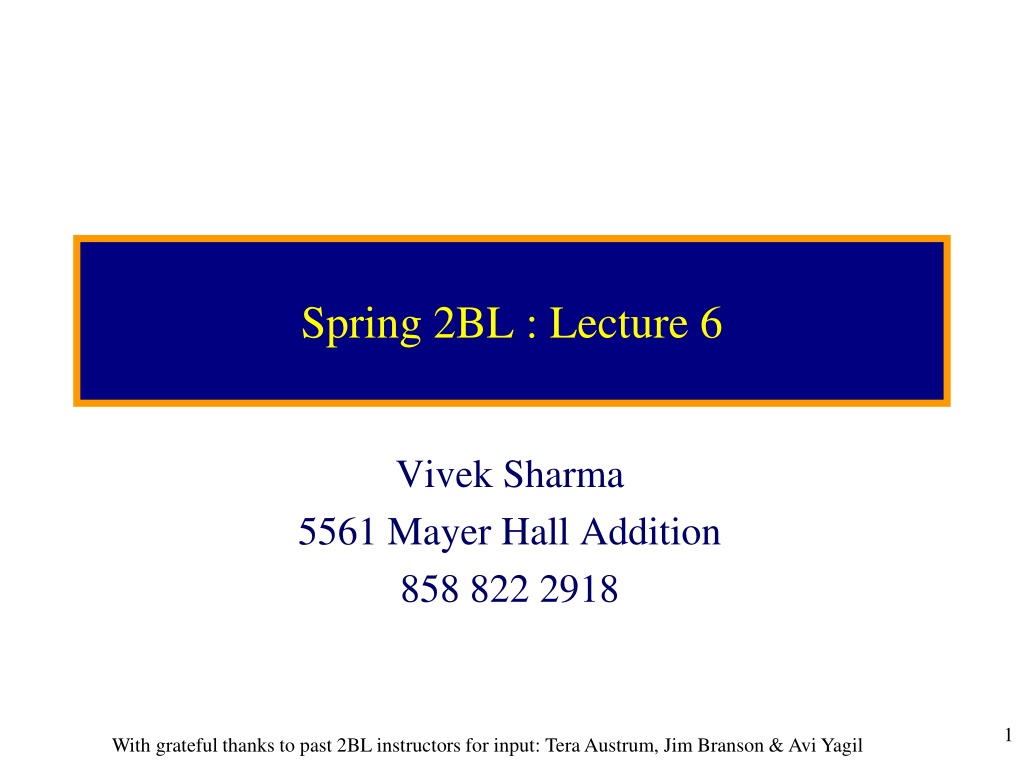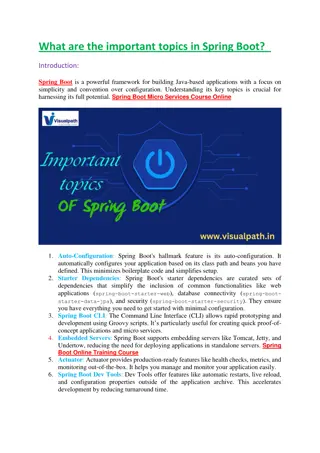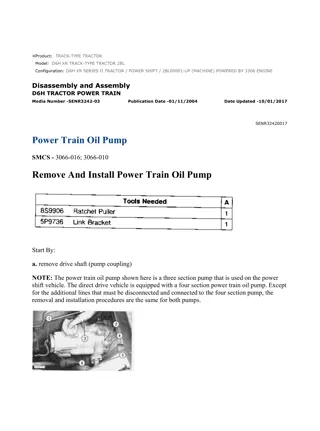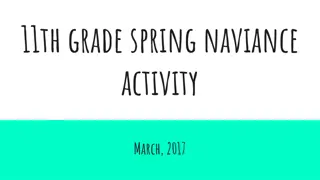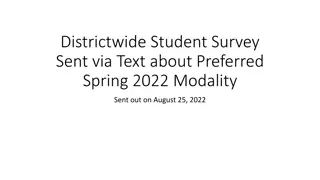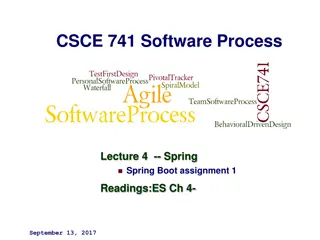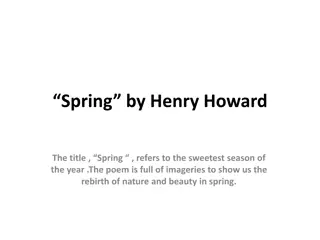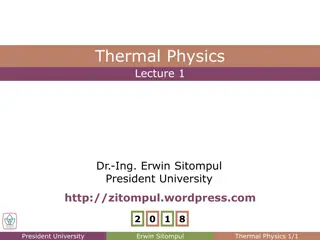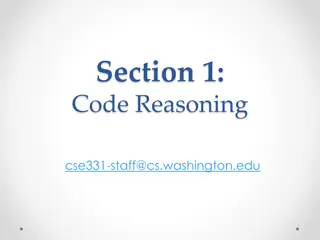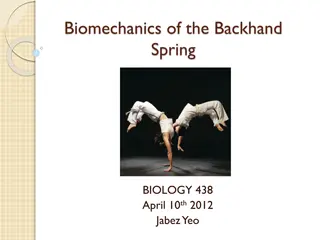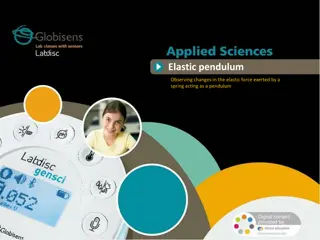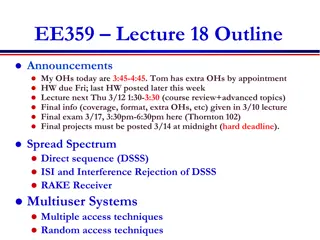Spring 2BL :Lecture 6
In this lecture, you will delve into Experiment #3, focusing on constructing and tuning a shock absorber to test a model for damping in a car's suspension system. The goal is to achieve critical damping for optimal performance, reducing oscillations and returning the system to equilibrium efficiently. Dive into the principles of a spring system at equilibrium, drag forces, and damping mechanisms to gain a comprehensive understanding.
Download Presentation

Please find below an Image/Link to download the presentation.
The content on the website is provided AS IS for your information and personal use only. It may not be sold, licensed, or shared on other websites without obtaining consent from the author. Download presentation by click this link. If you encounter any issues during the download, it is possible that the publisher has removed the file from their server.
E N D
Presentation Transcript
Spring 2BL : Lecture 6 Vivek Sharma 5561 Mayer Hall Addition 858 822 2918 1 With grateful thanks to past 2BL instructors for input: Tera Austrum, Jim Branson & Avi Yagil
Schedule For Week 6 This week ( A ) you will take data for Experiment #3 Construct and tune a shock absorber Read Chapter 8 and do HW from Taylor book 2
Experiment 3: Construct And Tune A Shock Absorber Goals: Test a model for damping Model of a shock absorber in car Procedure: develop and demonstrate critically damped system check out setup, take data, does data make sense ? Write up results - Does model work under all conditions, some conditions? Need modification? 3
Construct and test a critical damping system for a spring A shock absorber consists of a spring and a piston moving inside a cylinder with a damping liquid. The springs give you a gentle ride, so you do not feel every little dip and bump. However, if not substantially damped, the spring will go through many oscillations before returning to equilibrium (under- damping). On the other hand, by damping the springs too much (over-damping), you destroy any positive effect of the springs and make the suspension exceedingly hard. If the system is just right, we call it critically damped. It reduces shocks and returns the system to equilibrium within optimal (minimum) time. 4
A Spring System At Equilibrium D - D = = D , 0 x mg k x mg k x At elongation by length x = - + D = - ( ) Fnet mg k x x kx Newton + Hooke s Law k 2 d x = = - + = ; 0 ma kx m kx m 2 dt Equilibrium length ( ) t ( ) t = + cos x x x Simple Harmonic Oscillation 0 Amplitude 5
Drag Force Mass falls, gains velocity until the drag force balances the gravitational force: mg = = , 0 mg bv v t t b Terminal velocity Newton s 2nd Law mg y b + b + = y y g = m y m ( ) 0 = 0 y Velocity as a function of time: = t v t y 1 b t ( ) m e 1/(Time constant) 6
Spring System + Damping Damping Force: viscous friction proportional to velocity damping Newto + Hooke +damping Damping Force: F damp = Sum of Forces kx F net - = - - = - - , , bv bv ma kx bv Equation of motion for damped oscillator: 2 d x dx + + = 0 m b kx 2 dt Oscillatory? dt Exponential decay b - w ( ) i t 2 k- b = x x e 2 m w = Solution: where: 0 2 4m m 7
Case By Case Solutions (Under-damped) b General Solution: 2 k>> b - w t i t = x x e 2 m Case a: 2 4m m 0 2 k- b w = b 2 - 4m m t = w cos( ) x x e t 2 m 0 0x What is the physical meaning? Passing over a bump would result in oscillations that would continue for many cycles, making for an uncomfortable and unsafe ride. k - w 0x m 8
Case By Case Solutions (Over-damped) 2 b General Solution: k< b - w t i t Case c: = x x e 2 m 2 4m m 0 2 k- b w = t b2 4m2-k b 2 4m m - 2m- m x = x0e What is the physical meaning? No oscillatory term Exponential decay as if there are no springs 9
Case By Case Solutions (Critically-Damped) General Solution: b - w t i t 2 k= b = x x e 2 m Case b: 0 2 4m m 2 k- b w = b 2 - 4m m t = x x e 2 m (a) Under-damped (b) Critically damped (c) Over damped 0 What is the physical meaning? 0 x Soft suspension No oscillations = 2 bcrit mk - 0 x 10
Experiment Overview Mass hanging on a spring: For a given combination of spring and mass, calculate the damping required for critical damping bcrit 2 = mk Mass free-falling through a tube: Determine terminal velocity (and b) as a function of holes open. Find out how many holes need to be open for critical damping to be reached mg b = tv Put the above two together and test for critical damping Adjust the damping (# holes open) to provide critical-damping, and compare: by how much do the calculated value differs from the final adjusted value ? 11
Measuring The Spring Constant Measure oscillation period using a stop watch: p 2 k w = = T m 2 p 2 T = m k m Upon measuring the mass of the piston, m, the period of the pendulum T, you can compute the spring constant, k, and then calculate the damping coefficient, b, needed for critical damping: b = 2 mk 12
Terminal Velocity: To Measure Damping Coefficient b We let the piston drop in the cylinder without a spring. But with a pullout wire attached to it! After a short time a terminal velocity is reached and the net force and acceleration become zero (drag or damping force is equal to gravity force): v mg b bv mg = = , 0 t t h Use the full length available on the damping tube to get a good data set! h = vt t Dh Photogate v Dh- Height of the wide part of piston. h 13
Damping Coefficient b Depends On Air Flow Dominated by compression of air under the piston b b = 2 mk Dominated by friction between the piston and the cylinder walls n- open holes You need to adjust n (# of holes) so it satisfies b = 2 mk For fine adjustment you may want to use the valve 14
The Apparatus Valve + holes allow adjustment of air flow out of cylinder adjustment of b (a) Under-damped (b) Critically damped (c) Over damped 0 x - 0 x Do NOT overstretch spring Plexiglas cylinder used for damping. Need a just right fit. Match # on piston to # on damping tube Keep it stable (clamp to table!) 15
Construct & Test A Critical Damped System Measure mass m, period T v Compute the spring constant k Compute the damping coefficient b needed for critical damping h = 2 b mk Terminal velocity is reached when bv = mg Use terminal velocity measurements to determine b as a function of the number of holes covered and valve position Make sure to drop mass over the maximum range in heights!!!! = b 2 b mk Test spring plus shock absorber and optimize n-holes dominated by air flow dominated by friction 16
Checking The Spring Oscillator Careful taping of holes is crucial to good operation for terminal velocity and oscillation. Critical damping means no real oscillation but so does over-damping How can you tell the difference ?? Critical damping will have the smallest b with no oscillation. >>> Demonstrate this to your TA! 17
Demonstrate Critical Damping Check to convince yourself that Critical damping was achieved in your set up No oscillation (overshoot) Shortest time to return to equilibrium position 18
The Maximum Likelihood Principle The best estimate for X and s of N observed measurements xi are those for which Probability PX,s(xi) is maximum 19
The Maximum Likelihood Principle 2 ( ) x X 1 Recall the probability density for measurements of some quantity x. e = 2 ( ) x X P 2 , 2 Normal distribution is one example of P(x). Now, lets make repeated measurements of x to help reduce our errors. , , , ..., x x x x 1 2 3 n We define the Likelihood as the product of the probabilities. The larger L, the more likely a set of measurements is = ( ) ( P x P x P x ) ( )... ( ) L P x 1 2 3 n Is L a Probability? The best estimate parameters of P(x) are those that maximize L Why does max L give the best estimate? 20
Proof That Mean Is Best Estimate of True Value X L L X Assume X is a parameter of P(x). When L is maximum, we must have = 0 Xbest X Lets assume a Normal error distribution and find the formula for the best value for X. L X=0=Ce c2 X c2 X 2-1 c2 X -c2 2 n =0 L= P(x1)P(x2)...P(xn)= P(xi) i=1 n =1 s2 (xi- X)=0 2 n (xi-X )2 2s2 - (xi-X )2 2s2 - n 1 1 i=1 2pse 2sne L= = i=1 n n (xi- X)=0 (2p) i=1 i=1 n L=Ce-c22 xi-nX =0 (xi- X)2 s2 n i=1 X =1 c2= (definition) Q.E.D. the mean n xi i=1 n i=1 21
Error On The Mean n 1 n Formula for mean of measurements. (We ve shown that this is the best estimate of the true x.) = x x i = 1 i Now (simply) use propagation of errors to get the error on the mean. x x x x = ... x x x x x x 1 2 n 1 2 n 1 n x x = i What would you do if the xi had different errors? 2 2 n x = = = n i x n n n = 1 i We got the error on the mean (SDOM) simply by propagating errors. 22
Weighted Average We can use maximum Likelihood (c2) to average measurements with different errors. c 2 n x X = = 0 2 i 2 i X = 1 i 2 n x X n n 1 x c = 2 i = 0 X i 2 i 2 i n = = 1 i i = = 1 1 i i w x i i 1 We derive the result that = x 1 n i w i 2 i w i = 1 i n n = = 0 w x X w i i i From error propagation, we can determine the error on the weighted mean. = = 1 1 i i 1 n = w x x i i n = = w X 1 n i i = 1 i What does this give in the limit where all errors are equal? w i = 1 i 23
An Example Of Weighted Average Suppose 2 students measure the radius of Neptune. Student A gets r =80 Mm with an error of 10 Mm and student B gets r = 60 Mm with an error of 3 Mm. What is the best estimate of the true radius of Neptune ? 10080+1 1 100+1 1 960 r =wArA+wBrB wA+wB = =61.65 Mm 9 What does this tell you about the importance of error estimates? Is there a Democracy or a Meritocracy when it comes to measurements ? 24
